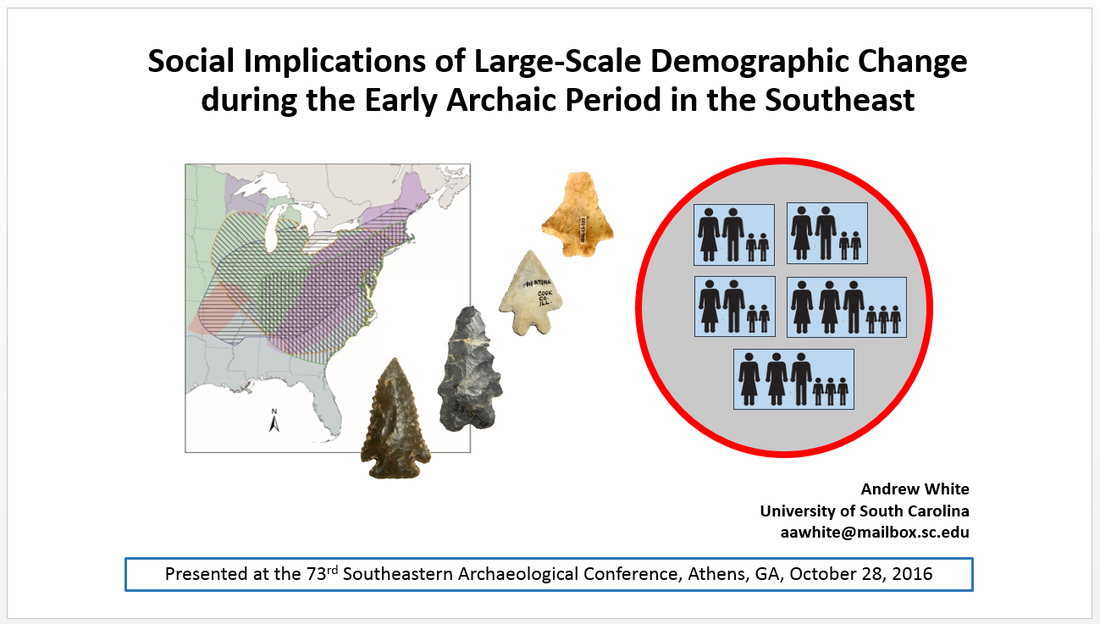|
I've loaded a pdf version of my 2016 SEAC presentation "Social Implications of Large-Scale Demographic Change During the Early Archaic Period in the Southeast" onto my Academia.edu page (you can also access a copy here). Other than a few minor alterations to complete the citations and adjust the slides to get rid of the animations, it's what I presented at the meetings last Friday. I tend to use slides as prompts for speaking, so some of the information that I tried to convey isn't directly represented on the slides. There's enough there that you can get a pretty good idea, I hope, of what I was going for.
Greg Little
11/2/2016 03:07:01 pm
I went through the slides carefully, but of course didn't hear the explanations and context. It's a strong case for abandonment. But, "why" those areas were abandoned is a relevant and important question. Do you have possible conclusions or answers to that question?
Greg Little
11/2/2016 04:27:50 pm
I suppose I should have added that I see the changes in environment. But that doesn't seem sufficient, at least for coastlines.
Andy White
11/3/2016 05:35:32 am
I think looking at a possible environmental component to an abandonment scenario is a logical first step. Environment isn't everything, of course, but it is fundamentally important to all human societies and critical to understanding how hunter-gatherer societies situate themselves and interact with the landscape. So it makes sense to look at it and develop some understanding of the environmental framework within which an abandonment process would have unfolded.
E.P. Grondine
11/3/2016 08:47:30 am
Hi Andy -
E.P. Grondine
11/3/2016 09:14:36 am
I need to add that in the southern Atlantic coastal plain deer will migrate from the mountains to the coast and back again annually.
Andy White
11/3/2016 09:32:00 am
And what's your source for that? Everything I've seen about white tailed deer suggests relatively small seasonal movements (say, usually less than 25 km). That won't necessarily get you out of Charleston County, let alone to the mountains.
E.P. Grondine
11/3/2016 04:53:02 pm
Hi Andy -
Andy White
11/8/2016 06:55:02 am
"I used to live by a migration corridor" is not exactly what I had in mind when I asked for a source.
E.P. Grondine
11/11/2016 07:01:32 am
You misunderstand.
Andy White
11/11/2016 12:03:24 pm
But that's not the pattern now. The deer are everywhere here, and they don't move that far. Hunting season in South Carolina doesn't exist only on the coast - it's everywhere.
Bill Wagner
9/13/2017 04:51:22 pm
Yes, Kirk does show the skimming pattern (thin density, wide expanse). But you also have climatic disruptions like droughts figuring into it. Case in point being Bolen, which is only found in areas with year-round springs, and tied to them (source = collector experience). Comments are closed.
|
All views expressed in my blog posts are my own. The views of those that comment are their own. That's how it works.
I reserve the right to take down comments that I deem to be defamatory or harassing. Andy White
Email me: [email protected] Sick of the woo? Want to help keep honest and open dialogue about pseudo-archaeology on the internet? Please consider contributing to Woo War Two.
Follow updates on posts related to giants on the Modern Mythology of Giants page on Facebook.
Archives
January 2024
Categories
All
|



 RSS Feed
RSS Feed
